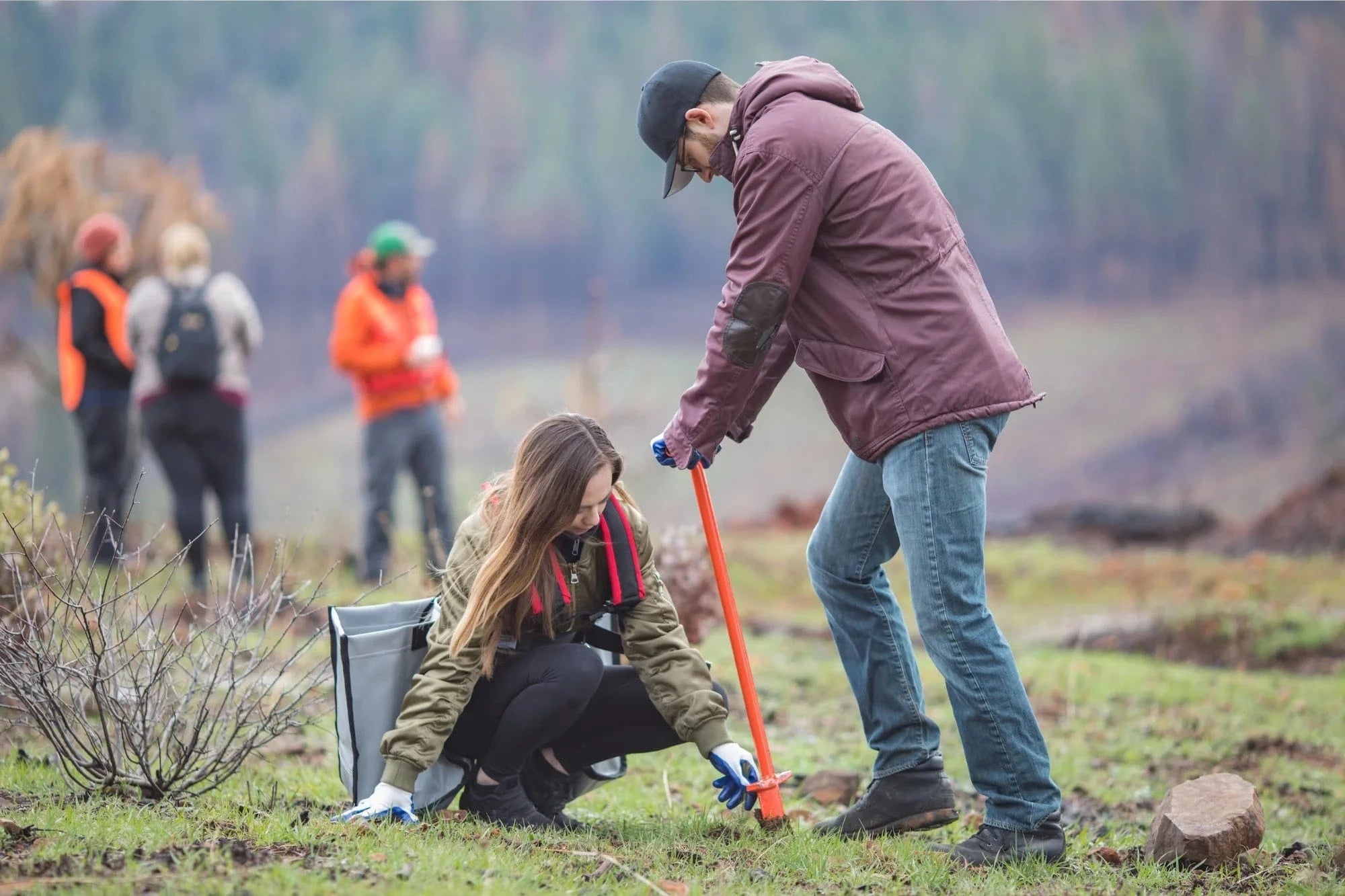
Get news, updates, & event Info delivered right to your inbox:
Understanding The Importance of Forests
Have you ever stopped to wonder why forests are so important for the well-being of humans and animals, and the overall health of our planet? From the air we breathe to the food we eat, trees play a critical role in sustaining life on Earth. In this article, we’ll dive into six reasons why thriving forests are key to a healthy planet.
6 Major Benefits The World's Forests Provide

1. How Forests Improve Air Quality
Trees improve air quality in a few key ways, including by absorbing greenhouse gases, “collecting” particulate pollutants, and emitting oxygen. So how do they do it?
Through the process of photosynthesis, trees absorb carbon dioxide and water from the air and soil. Within their plant cells, solar energy and chemical reactions convert the water into oxygen and the carbon into glucose. The glucose is stored by the tree, while the oxygen is released back into the air.
Through their leaves and bark, trees absorb harmful gaseous air pollutants such as sulfur dioxide, nitrogen dioxide, ozone, and carbon monoxide. Once absorbed, these gases diffuse within the inner surfaces of the leaves, and are broken down.
Trees also “capture” particulate matter (like dust and smoke) on their vegetative surfaces. When it rains, these particulates wash off and are carried into the soil or dissolved in stormwater.

2. How Forests Purify Water and Protect Against Natural Disasters
Trees play a key role in capturing rainwater and reducing the risk of natural disasters like floods and landslides. Their intricate root systems pull water from the soil, where it works its way upward through specialized tissues. This eventually is released through stomata (pores) on the surface of leaves. Trees can absorb between 10-150 gallons of water a day, but they only keep about 5% of that for their own growth.
Trees also intercept water on the surfaces of their leaves, branches and trunks during rainfall. Eventually, influenced by factors like sunlight, temperature, humidity, and wind, that water evaporates back into the atmosphere. Through this combined process of evapotranspiration, trees release nearly 95% of the water they absorb, in the form of water vapor.
Because trees can absorb and slowly release so much water, they function like nature’s “water managers.” They help improve the quality of stormwater runoff before it hits waterways, help cool the surrounding atmosphere by releasing water vapor, and prevent or reduce the intensity of natural disasters.

3. How Forests Help Protect Biodiversity
Today, over 1 million animal and plant species are threatened with extinction—many within the next few decades. From soil to canopy, healthy forest ecosystems contain an incredible range of life—including fungi, microbes, plants and animals. They provide a diverse selection of habitats, including in their canopy, understory, and forest floor.
The world's forests are home to 80% of amphibian species, 75% of bird species, and 68% of mammal species living on land. They also provide migration corridors for wildlife, enabling animals to move between different habitats and ensuring that populations can mix and remain genetically diverse. With the many threats to biodiversity today, it is critical to protect and restore forest ecosystems around the world.

4. How Forests Provide Social Impact
Over 1.6 billion people depend on forests for timber, food, fuel, jobs, and shelter. These communities are most directly impacted when trees are cut down, but we all rely on the ecosystem services that the world’s forests provide. Collectively, these services are valued at an estimated $16.2 trillion (USD) annually.
To communities that directly depend on forests, they can be a lifeline—providing wild fruits, nuts and medicinal plants, as well as cooking fuels and other non-timber forest products. People also subsist off of the the fish and game that live in forest habitats. Many of these communities have more than an extractive relationship with trees and forests, though. For communities around the world, trees represent rich cultural values and traditional knowledge, gleaned from generations of living within and off of the land.
Food-producing trees that are grown and managed within sustainable agroforestry systems can also provide fruits, nuts, berries, and leaves. Over time, sustainable agroforestry helps foster sustainable socioeconomic development, improve food security, and more.

5. How Forests Improve Our Health and Well-Being
Trees and forests provide powerful health benefits. Around 25% of all medicinal drugs in the developed world come from plants. In developing countries, it’s as high as 80%. Aside from providing many herbal and conventional medicines, forests improve our air and water quality, reduce stress, and help improve our mental health.
Numerous studies have demonstrated that the presence of trees in urban settings can improve mental health by reducing stress; living in areas that have more green space correlates with lower levels of the stress hormone cortisol. In addition, trees and green spaces are linked to less negative thoughts, less symptoms of depression, better mood (self-reported), and increased life satisfaction.
Cultures around the world have recognized the power of trees to heal, and integrate forest medicine with their healing systems. For example, forest bathing, or Shirin-Yoku, is the Japanese practice of spending time in nature and connecting with the natural world through our five senses.

6. How Forests Help Mitigate Climate Change
Forests currently absorb 30% of the CO2 that is emitted globally. Crucially, a majority of this carbon resides in forest soils, anchored by networks of symbiotic roots, fungi and microbes. Because of this, they are typically considered carbon sinks (places that absorb more carbon than they release). So how do they do it?
Forest soils contain carbon in the form of plant roots, leaf litter, and other organic material that has broken down. How much carbon a forest soil holds depends on its unique soil makeup. For example, clay soils can bind a lot of carbon, while sandy soils hold significantly less. Soils that are frozen for much of the year, such as in Canada’s tundra, hold more carbon, because decomposition happens much more slowly. But how does the carbon get into forest soils in the first place?
As mentioned above, trees absorb carbon dioxide (and water) during the process of photosynthesis, bind it up in glucose, and release oxygen. They use this glucose to grow their trunks, branches, and roots. On average, the woody tissue of trees is comprised of about 50% carbon.
As you may have guessed, the carbon in forests eventually does get released back into the atmosphere through the processes of respiration, decomposition, and combustion. However, by protecting existing forests and planting new trees where ecologically appropriate, we can leverage the incredible potential of forests to help mitigate climate change.
In conclusion, thriving forests are more than one of the world's natural wonders—they form an essential foundation for life on Earth. Trees help regulate our climate, purify the air we breathe, provide habitats for countless species, and offer critical services that support our daily lives.
Protecting and preserving forests is not only vital for the survival of many species, but for our own well-being and the future our our planet. By understanding the critical role forests play and actively supporting reforestation, we can help ensure a healthier planet for generations to come. So, let’s take action today—because nature can't wait.
Get news, updates, & event Info delivered right to your inbox:
Related Posts
9 Sustainable New Years Resolutions
18/12/2025 by Meaghan Weeden
Inspirational Quotes About Trees
16/12/2025 by Meaghan Weeden
The 9 Oldest, Tallest, and Biggest Trees in the World
11/12/2025 by One Tree Planted
Popular On One Tree Planted
Inspirational Quotes About Trees
16/12/2025 by Meaghan Weeden
The 9 Oldest, Tallest, and Biggest Trees in the World
11/12/2025 by One Tree Planted
What Causes Deforestation?
10/07/2025 by Meaghan Weeden
Fundraising Disclosures

Be Part of the
Restoration Movement
The Grove is more than just a monthly giving program: it's a vibrant community of individuals who are dedicated to reforestation and environmental restoration on a global scale.
As a member of The Grove, you affirm your commitment to restoring forests, nurturing biodiversity, and fostering positive global change.



